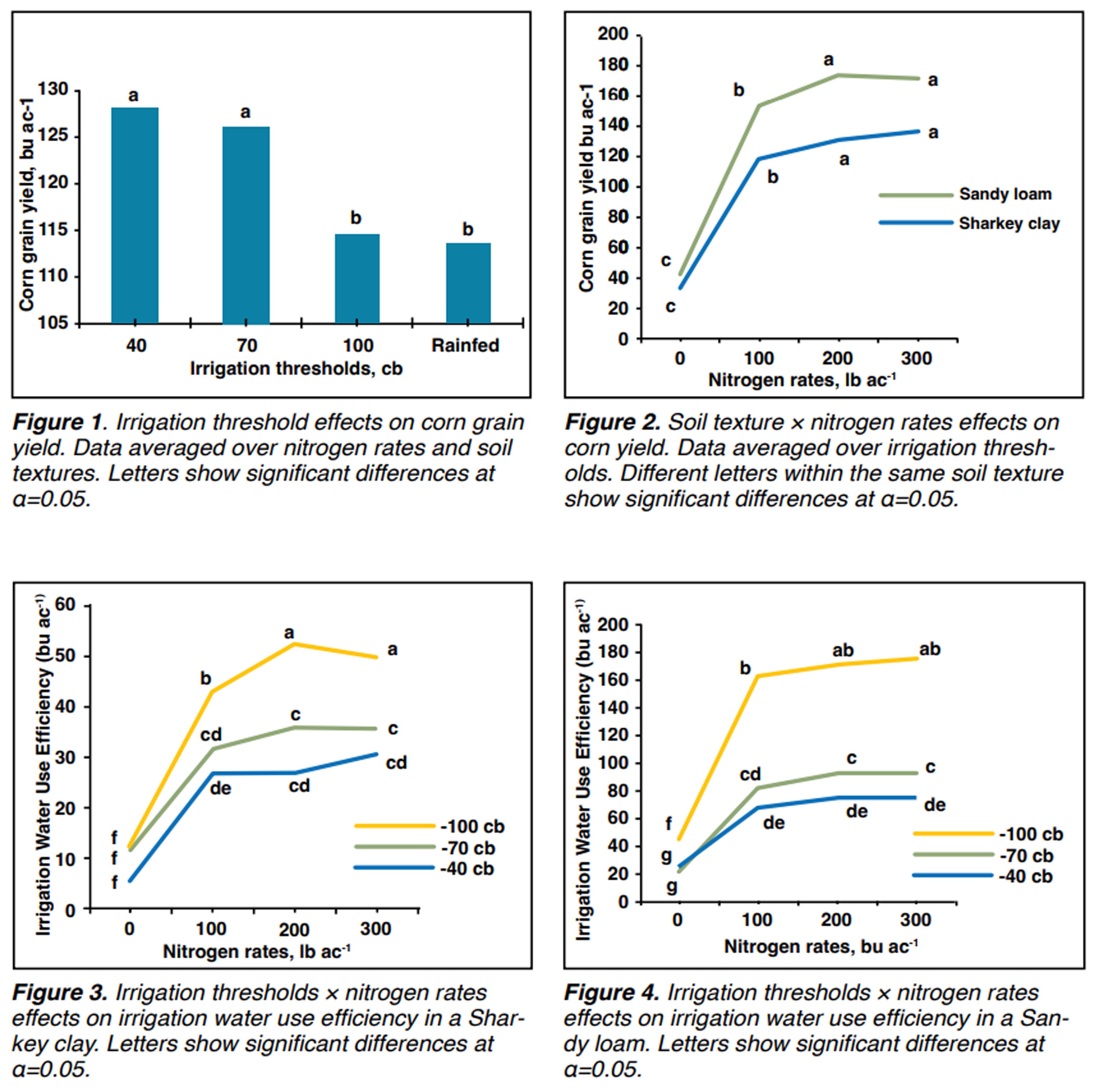Research Project
Irrigation thresholds and nitrogen rates effects on irrigated corn grain yield and water use efficiency under a sprinkler irrigation system
Investigators: Amilcar Vargas, Drew Gholson, Himmy Lo, Gurbir Singh, Dave Spencer, and Jason Krutz
Date: 2022
Project Summary
Introduction
Groundwater resource is the most exploited resource to irrigate row crops in the Mississippi Delta. The overuse and excessive pumping from agriculture and fisheries has exceeded the natural water recharge of the Mississippi River Valley Alluvial Aquifer (MRVAA). Limited research has been conducted on the use of overhead irrigation in corn production systems in the Mississippi Delta. Water and nitrogen are considered the major driving factors for corn production. Therefore, understanding the relationship between sensor-based irrigation and nitrogen rates on corn grown in sandy loam and clay under a sprinkler irrigation would help to reduce the groundwater withdrawals from MRVAA.
Materials and Methods
This study was conducted at Delta Research and Extension Center, Mississippi State University, Stoneville, MS in 2022. Corn hybrid DKC 65-93 was planted on May 05 at 35,000 seeds acre-1 in a twin row pattern. Treatments were three irrigation scheduling thresholds, based on soil water tension (-40, -70, -100 cb, and rainfed control), four nitrogen rate (0, 100, 200, and 300 lbs N ac-1), and two distinct soil textural classes (Sandy Loam and Clay). The nitrogen source was urea ammonium nitrate (UAN, 32%) applied in a single application at V6 growth stage. Field management operations such as tillage, weed, and pest control were conducted following Mississippi State University Extension Service recommendations. All treatments were replicated five times. The plot size for individual nitrogen rate treatment was 26.6 x 50 feet. In total there were 160 plots (Picture 1). Soil moisture sensors were installed at 6, 12, and 24 inches to determine soil moisture tension. Irrigation was triggered when the weighted average of the three sensors reached the irrigation threshold. Sensors at 6 and 12 inches were assigned 0.25 weight value each and 0.50 for the 24 inches depth sensor. Irrigation water use efficiency was calculated based on corn grain yield divided by the total amount of water applied to each plot. Irrigation was terminated when black layer was developed. The two middle rows from each plot were harvested using a plot combine. Corn grain weight per each plot was recorded. Corn grain yield was adjusted to 15.5% moisture. Analysis of variance was performed using the GLIMMIX procedure in SAS statistical software. Mean separations were performed using Fisher's protected LSD at ? = 0.05.
Results and Discussion
Corn grain yield was affected by irrigation thresholds (Figure 1) and the two-way interaction between soil texture x nitrogen rates (Figure 2). Irrigation water use efficiency was influenced by the three-way interaction of soil type x irrigation threshold x nitrogen rate. There were no differences between the irrigation thresholds of -40 and -70 cb in corn grain yield, when averaged over soil texture and nitrogen rates. Using a lower irrigation threshold (i.e. -70 cb) will reduce the amount of water to irrigate corn and consequently preserve the Mississippi River Valley Aquifer. Overall, corn grown in a sandy loam soil had higher corn grain yield compared to corn grown in a Sharkey clay (Figure 2). Interestingly, there is no difference in corn grain yield when 200 or 300 lb ac-1 of nitrogen were applied in both sandy loam and Sharkey clay. For both soil textures, sandy loam and Sharkey clay the -100 cb had the highest IWUE. In a Sharkey clay soil, there were no differences in IWUE triggering irrigation at -70 and -40 cb. However, in a sandy loam soil triggering irrigation -40 cb had the lowest IWUE efficiency.
Irrigation and nutrient management practices that are site specific will increase corn productivity and water use efficiency and in the Mississippi Delta.
Project Photos

- Topic:
- Irrigation scheduling
- Irrigation
Find Research
By Crop Type
By Topic
Contact NCAAR
General Information
Kaye Sullivan
vfs23@msstate.edu
662.390.8510
F:662.390.8501
Showcase Demo
Drew Gholson, Coordinator
drew.gholson@msstate.edu
662.390.8505
Himmy Lo
himmy.lo@msstate.edu
662.390.8509

